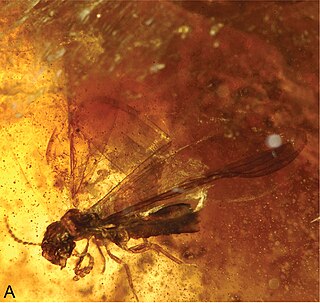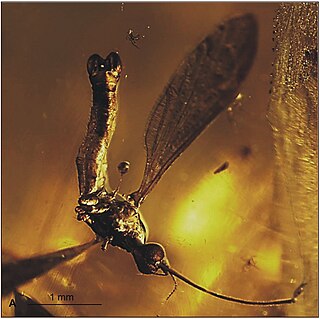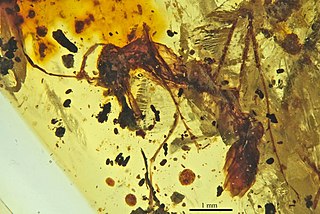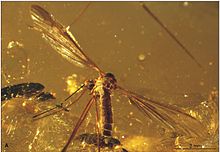Paleontology or palaeontology is the study of prehistoric life forms on Earth through the examination of plant and animal fossils. This includes the study of body fossils, tracks (ichnites), burrows, cast-off parts, fossilised feces (coprolites), palynomorphs and chemical residues. Because humans have encountered fossils for millennia, paleontology has a long history both before and after becoming formalized as a science. This article records significant discoveries and events related to paleontology that occurred or were published in the year 1869.

Sphecomyrma is an extinct genus of ants which existed in the Cretaceous approximately 79 to 92 million years ago. The first specimens were collected in 1966, found embedded in amber which had been exposed in the cliffs of Cliffwood, New Jersey, by Edmund Frey and his wife. In 1967, zoologists E. O. Wilson, Frank Carpenter and William L. Brown, Jr. published a paper describing and naming Sphecomyrma freyi. They described an ant with a mosaic of features—a mix of characteristics from modern ants and aculeate wasps. It possessed a metapleural gland, a feature unique to ants. Furthermore, it was wingless and had a petiole which was ant-like in form. The mandibles were short and wasp-like with only two teeth, the gaster was constricted, and the middle and hind legs had double tibial spurs. The antennae were, in form, midway between the wasps and ants, having a short first segment but a long flexible funiculus. Three additional species, S. canadensis, S. mesaki and S. nexa, were described in 1985, 2005, and 2024, respectively.
Paleontology or palaeontology is the study of prehistoric life forms on Earth through the examination of plant and animal fossils. This includes the study of body fossils, tracks (ichnites), burrows, cast-off parts, fossilised feces (coprolites), palynomorphs and chemical residues. Because humans have encountered fossils for millennia, paleontology has a long history both before and after becoming formalized as a science. This article records significant discoveries and events related to paleontology that occurred or were published in the year 1851.
Paleontology or palaeontology is the study of prehistoric life forms on Earth through the examination of plant and animal fossils. This includes the study of body fossils, tracks (ichnites), burrows, cast-off parts, fossilised feces (coprolites), palynomorphs and chemical residues. Because humans have encountered fossils for millennia, paleontology has a long history both before and after becoming formalized as a science. This article records significant discoveries and events related to paleontology that occurred or were published in the year 1850.

Elephantomyia is a genus of crane fly in the family Limoniidae.

Tytthodiplatys is an extinct genus of earwig in the family Diplatyidae known from a Cretaceous fossil found in Myanmar. The genus contains a single described species, Tytthodiplatys mecynocercus.

Arostropsis is an extinct genus of broad-nosed weevil in the beetle family Curculionidae known from an Upper Eocene fossil found in Europe. The genus contains a single described species, Arostropsis groehni.

Nanotermes is an extinct genus of termites in the Isoptera family Termitidae known from only one Eocene fossil found in amber of the Cambay Basin. The genus contains a single described species, Nanotermes isaacae placed tentatively in the subfamily Termitinae.

Brownimecia is an extinct genus of ants, the only genus in the tribe Brownimeciini and subfamily Brownimeciinae of the Formicidae. Fossils of the identified species, Brownimecia clavata and Brownimecia inconspicua, are known from the Late Cretaceous of North America. The genus is one of several ants described from Late Cretaceous ambers of New Jersey. Brownimecia was initially placed in the subfamily Ponerinae, until it was transferred to its own subfamily in 2003; it can be distinguished from other ants due to its unusual sickle-like mandibles and other morphological features that makes this ant unique among the Formicidae. B. clavata is also small, measuring 3.43 millimetres (0.135 in), and a stinger is present in almost all of the specimens collected. The morphology of the mandibles suggest a high level of feeding specialization.

Haidoterminus is an extinct genus of ant in the Formicidae subfamily Haidomyrmecinae, and is one of only nine genera placed in this subfamily. The genus contains a single described species Haidoterminus cippus and is known from one Late Cretaceous fossil which has been found in North America.

Electrostephanus is an extinct genus of crown wasp in the hymenopteran family Stephanidae, and is the only genus placed in the subfamily Electrostephaninae. The genus contains four described species, E. brevicornis, E. neovenatus, E. janzeni, and E. petiolatus, placed in two subgenera E. (Electrostephanus) and E. (Electrostephanodes). Electrostephanus is known from several middle Eocene fossils which have been found in Europe.
Feroseta is an extinct genus of mantidfly in the neuropteran family Mantispidae known from a fossil found in North America, and which contains a single species, Feroseta prisca.
Xylolaemus sakhnovi is an extinct species of cylindrical bark beetle in the family Zopheridae. The species is solely known from the Middle Eocene Baltic amber deposits in the Baltic Sea region of Europe. The genus Xylolaemus contains a total of six extant species distributed from western Europe through the Canary Islands and North Africa to India. The species is the first in the genus to be described from a fossil specimen.

Elephantomyia (Elephantomyia) baltica is an extinct species of crane fly in the family Limoniidae. The species is solely known from the Middle Eocene Baltic amber deposits in the Baltic Sea region of Europe. The species is one of six described from Baltic amber.

Elephantomyia (Elephantomyia) brevipalpa is an extinct species of crane fly in the family Limoniidae. The species is solely known from the Middle Eocene Baltic amber deposits in the Baltic Sea region of Europe. The species is one of six described from Baltic amber.

Elephantomyia (Elephantomyia) bozenae is an extinct species of crane fly in the family Limoniidae. The species is solely known from the Middle Eocene Baltic amber deposits in the Baltic Sea region of Europe. The species is one of six described from Baltic amber.

Elephantomyia (Elephantomyia) irinae is an extinct species of crane fly in the family Limoniidae. The species is solely known from the Middle Eocene Baltic amber deposits in the Baltic Sea region of Europe. The species is one of six described from Baltic amber.

Myanmyrma is an extinct genus of ants not placed into any Formicidae subfamily. Fossils of the single known species, Myanmyrma gracilis, are known from the Middle Cretaceous of Asia. The genus is one of several ants described from Middle Cretaceous ambers of Myanmar.

Elephantomyia (Elephantomyia) pulchella is an extinct species of crane fly in the family Limoniidae. The species is solely known from the Middle Eocene Baltic amber deposits in the Baltic Sea region of Europe. The species is one of six described from Baltic amber.

Bradoponera is an extinct genus of ant in the Formicidae subfamily Proceratiinae, and is one of four genera of the subfamily. The genus contains four described species Bradoponera electrina, Bradoponera meieri, Bradoponera similis, and Bradoponera wunderlichi. The species are known from several Middle Eocene amber fossils which were found in Europe.














